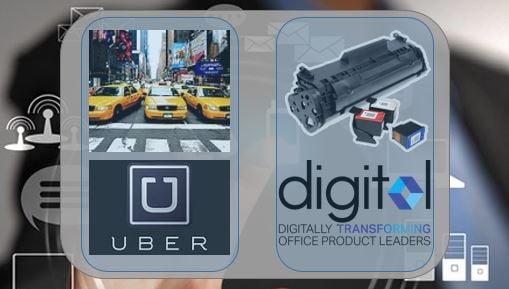How could anyone think there's anything in common between Uber and Office Products? High-tech transportation versus ink, toner, and paper clips! "I don't think so!" I hear you all saying. Well, hold on for a moment and think about the following.
The taxi business is a big industry involving a lot of dollars. According to the New York City Taxi & Limousine Commission Report of 2014, there is an average of 485,000 Yellow Taxi trips in New York City per day with an average fare of $13.40. That adds up to $2.4 billion annually for New York City Yellow Cabs. You start to see why Uber was drawn to the paid-ride business.
Let's assume the average cost of an Uber ride in New York City is 70% of a regulated Yellow Taxi fare, or $9.38. If 100% of rides converted from Yellow Taxis to Uber rides, the overall cost in New York City would decrease from $2.4 billion to $1.7 billion - saving consumers $700 million per year.
The Uber founders saw an opportunity to disintermediate the taxi cartel and its government-sponsored medallion system initially introduced in the 1930s. In 2014 a medallion (license to operate a Yellow Taxi) cost nearly $1 million, and historically, claims have generated a 10% ROI for their owners. Of course, that ROI is incrementally earned through fares paid by consumers - think, perhaps, overpaying!
However, two to three years on, the market price for a Medallion is down nearly 50% to $500,000. Many investors, who didn't see the Uber disruptor coming, are now "underwater" by hundreds of thousands of dollars on mortgages owed on the medallions. This reduction in the value of a Medallion is directly related to the entry of Uber and other similar rival services.

Now let's switch gears to the ink and toner business, where $25 billion is spent yearly in the United States. 80% of this spend ($20 billion) is on original brand (OEM) cartridges, such as those provided by Hewlett Packard, Brother, Samsung, etc. The remaining $5 billion is spent on aftermarket cartridges that may sell between 10% and 70% of the typical OEM cartridge price.
Let's momentarily focus on the $20 billion OEM ink and toner spent. Most of these cartridges are sold through the Big-Box channels such as Office Depot and Staples. These resellers typically don't promote aftermarket cartridges; those they do are usually at the top end of the aftermarket pricing scale (i.e., 70% or so of the OEM price).
When Uber came along, it disintermediated the Yellow Taxi service through technology and the App customers installed on their smartphones. This enabled waiting times, cash, and tips to all be eliminated. Consumers have been deserting Yellow Taxis in droves ever since.
American businesses have mostly purchased their office products from Office Depot, Staples, and other Big-Box outlets, evidently not believing (or knowing) there are other viable options (resellers) for them to select from. Until now, it's been almost impossible to disintermediate the Big Box resellers.
There’s really “no other place besides Office Depot and Staples to get everything you need for your office," said Scott Wagner, a partner at law firm Bilzin Sumberg and an antitrust expert. "But everything you can get there, you can get somewhere else.”
The taxi business is not very sexy, but a disruptor still saw the opportunity, deployed technology, and turned the entire industry on its head. The office products business is also not very sexy but, besides this subjective element, has other economic similarities to the taxi model. Uber depends on thousands of independent drivers to hit the road when they choose to, joining the Uber Platform and connecting supply (their vehicle and driving service) to demand (paying customers wanting a ride).
Thousands of independent office product resellers struggle to compete with the OEM marketing machine and the Big Box resellers with their combined grip on corporate America.
Uber is more convenient, has a better experience, and usually costs less than a Yellow Taxi ride. Aftermarket office supplies can offer just as good an experience as the OEM brand while saving consumers significant money.
The only piece of the puzzle that's been missing is the "Office Products" equivalent of the Uber Platform that's necessary for the independent resellers to start to disintermediate the Big Box resellers. A Platform that has the potential to save consumers up to $6 billion per year. ($20 Billion x 70% = $14 billion = $6 billion saving).
Joining the Platform, enabling technology to ensure transactional efficiency, logistical reliability, and a customer experience comparable to that currently provided by the Big Box resellers means the final piece of the puzzle is now available. Not only may this facilitate consumers to enjoy up to $6 billion in annual savings, but it may also transform the outlook for office supplies dealerships!

Инновационные решения позволяют организовать высокое качество изображения даже при слабом освещении.
Наша компания предоставляет множество решений систем, подходящих для офиса.
<a href="https://videonablyudeniemoskva.ru/">videonablyudeniemoskva.ru</a>
Грамотная настройка и техническая поддержка обеспечивают простым и надежным для каждого клиента.
Свяжитесь с нами, чтобы получить лучшее решение для установки видеонаблюдения.